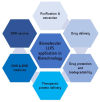Biomolecular Liquid-Liquid Phase Separation for Biotechnology
- PMID: 37092470
- PMCID: PMC10123627
- DOI: 10.3390/biotech12020026
Biomolecular Liquid-Liquid Phase Separation for Biotechnology
Abstract
The liquid-liquid phase separation (LLPS) of biomolecules induces condensed assemblies called liquid droplets or membrane-less organelles. In contrast to organelles with lipid membrane barriers, the liquid droplets induced by LLPS do not have distinct barriers (lipid bilayer). Biomolecular LLPS in cells has attracted considerable attention in broad research fields from cellular biology to soft matter physics. The physical and chemical properties of LLPS exert a variety of functions in living cells: activating and deactivating biomolecules involving enzymes; controlling the localization, condensation, and concentration of biomolecules; the filtration and purification of biomolecules; and sensing environmental factors for fast, adaptive, and reversible responses. The versatility of LLPS plays an essential role in various biological processes, such as controlling the central dogma and the onset mechanism of pathological diseases. Moreover, biomolecular LLPS could be critical for developing new biotechnologies such as the condensation, purification, and activation of a series of biomolecules. In this review article, we introduce some fundamental aspects and recent progress of biomolecular LLPS in living cells and test tubes. Then, we discuss applications of biomolecular LLPS toward biotechnologies.
Keywords: biocatalysts; biomolecules; biotechnology; drug delivery; drug protection; liquid–liquid phase separation.
Conflict of interest statement
The authors declare no conflict of interest.
Figures




Similar articles
-
Biological soft matter: intrinsically disordered proteins in liquid-liquid phase separation and biomolecular condensates.Essays Biochem. 2022 Dec 16;66(7):831-847. doi: 10.1042/EBC20220052. Essays Biochem. 2022. PMID: 36350034 Review.
-
Liquid-liquid phase separation in cell physiology and cancer biology: recent advances and therapeutic implications.Front Oncol. 2025 Mar 31;15:1540427. doi: 10.3389/fonc.2025.1540427. eCollection 2025. Front Oncol. 2025. PMID: 40231263 Free PMC article. Review.
-
Fixation can change the appearance of phase separation in living cells.Elife. 2022 Nov 29;11:e79903. doi: 10.7554/eLife.79903. Elife. 2022. PMID: 36444977 Free PMC article.
-
Liquid-liquid phase separation in microorganisms: Insights into existence, functions, and applications.Microbiol Res. 2025 Mar;292:128026. doi: 10.1016/j.micres.2024.128026. Epub 2024 Dec 17. Microbiol Res. 2025. PMID: 39705832 Review.
-
The property and function of proteins undergoing liquid-liquid phase separation in plants.Plant Cell Environ. 2024 Oct;47(10):3671-3684. doi: 10.1111/pce.14988. Epub 2024 May 29. Plant Cell Environ. 2024. PMID: 38808958 Review.
Cited by
-
Trifluoroacetic Acid as a Molecular Probe for the Dense Phase in Liquid-Liquid Phase-Separating Peptide Systems.Anal Chem. 2025 Jan 14;97(1):166-174. doi: 10.1021/acs.analchem.4c03444. Epub 2024 Dec 22. Anal Chem. 2025. PMID: 39710972 Free PMC article.
-
Alteration in the Sensitivity of Firefly Bioluminescence to pH Driven by Molecular Recruitment to Coacervate Droplets.ACS Omega. 2025 Jun 9;10(24):25313-25321. doi: 10.1021/acsomega.4c11259. eCollection 2025 Jun 24. ACS Omega. 2025. PMID: 40584389 Free PMC article.
-
A computational pipeline for image-based statistical analysis of biomolecular condensates dynamics using morphological descriptors.Sci Rep. 2025 Jul 29;15(1):27560. doi: 10.1038/s41598-025-09148-y. Sci Rep. 2025. PMID: 40730560 Free PMC article.
-
Protein condensates in the the secretory pathway: Unraveling biophysical interactions and function.Biophys J. 2024 Jun 18;123(12):1531-1541. doi: 10.1016/j.bpj.2024.04.031. Epub 2024 May 2. Biophys J. 2024. PMID: 38698644 Free PMC article. Review.
-
METTL1 promotes cadmium-induced stress granules formation via enhancing translation of G3BP1 and expression of m7G- 3' tiRNA MetCAT.Cell Biol Toxicol. 2025 Aug 5;41(1):124. doi: 10.1007/s10565-025-10072-0. Cell Biol Toxicol. 2025. PMID: 40762925 Free PMC article.
References
Publication types
Grants and funding
LinkOut - more resources
Full Text Sources
